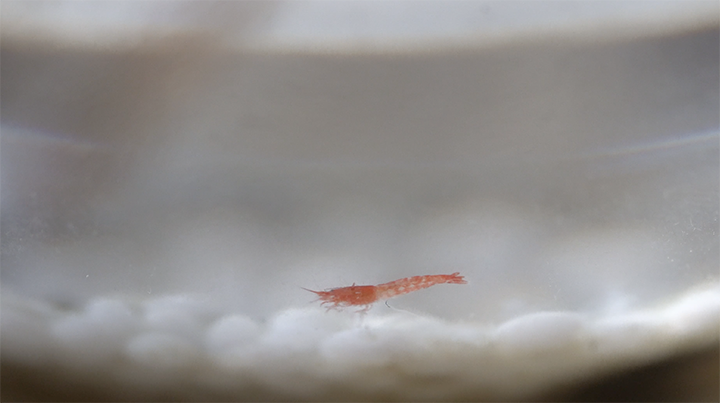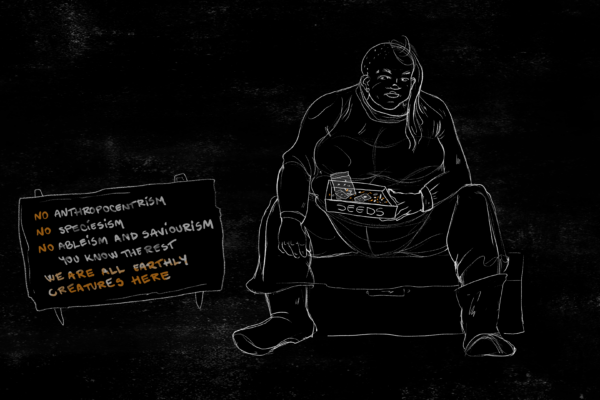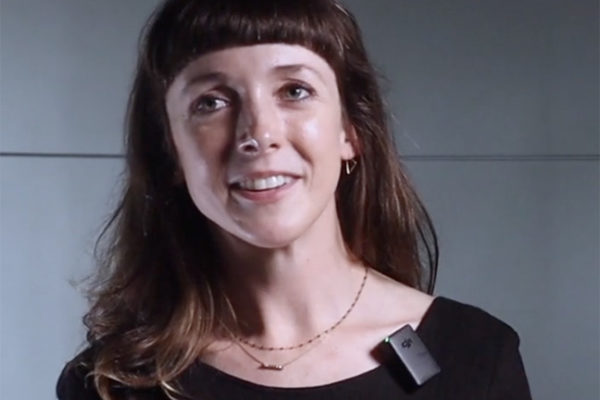Filmmaker Matt Maraynes received a 2024 CAF grant to shoot a documentary short about a shrimp, Vincent. But he found himself in a dilemma . . .
In 2024 the Culture & Animals Foundation awarded me a grant to put towards a short documentary film, The Loneliest Shrimp in the World. Soon after I began filming, it became clear that, despite the grant’s purpose, any cinematic product born of the process would be secondary to my effort to try to improve the welfare of a nonhuman animal.
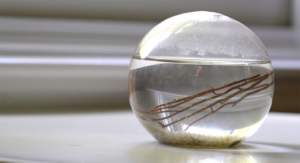 The animal in question—and the subject of the film—is Vincent, an ōpaeʻula (pronounced “oh-pie-oo-luh”), also known as the Hawaiian red shrimp. For over a decade, Vincent has been living in a hermetically sealed glass ball called an EcoSphere (left below), a product once sold by the now defunct EcoSphere Associates. About the size of a softball, Vincent’s EcoSphere came filled a variety of biotic and abiotic components intended to exist in harmony to produce a self-sustaining ecosystem: some seawater, dead coral, algae, bacteria, and about ten ōpaeʻula, each the size of a human fingernail. I was given this EcoSphere in the early 2010s and marveled at it on and off over the years. Then life happened. I forgot all about it. Last year I rediscovered the EcoSphere gathering dust on a bookshelf in my childhood home. One shrimp remains: Vincent.
The animal in question—and the subject of the film—is Vincent, an ōpaeʻula (pronounced “oh-pie-oo-luh”), also known as the Hawaiian red shrimp. For over a decade, Vincent has been living in a hermetically sealed glass ball called an EcoSphere (left below), a product once sold by the now defunct EcoSphere Associates. About the size of a softball, Vincent’s EcoSphere came filled a variety of biotic and abiotic components intended to exist in harmony to produce a self-sustaining ecosystem: some seawater, dead coral, algae, bacteria, and about ten ōpaeʻula, each the size of a human fingernail. I was given this EcoSphere in the early 2010s and marveled at it on and off over the years. Then life happened. I forgot all about it. Last year I rediscovered the EcoSphere gathering dust on a bookshelf in my childhood home. One shrimp remains: Vincent.
EcoSpheres are purported to be able to support their ecosystems for years—perhaps even decades. The secret to their success? The hardy ōpaeʻula. Native to the brackish anchialine (volcanic) pools of Hawaii, these animals can thrive in an array of environmental conditions and tolerate wide swings in temperature, salinity, and chemical composition, among other factors. They are also long-lived, which makes them ideal candidates for surviving in a small amount of water slowly being filled with their own waste over a period of years.
For the past year I have filmed Vincent up close with a macro lens, and have fallen down a research-and-interview rabbit hole to better understand him. Given their native habitats (lava tubes, tide pools), ōpaeʻula love darkness. Given the choice, they prefer to hide. Unlike most other shrimps, they only reproduce one or two times per year, generating ten to twenty babies at a time. They’re mildly social and almost always prefer to congregate in groups with conspecifics.
Vincent is a social animal and he is all alone. His species likes hiding in dark places but in an EcoSphere, there is nowhere to hide. His environment is also, in a sense, a ticking time bomb. Although the EcoSphere is sealed, small amounts of water very gradually evaporate through the orb’s epoxied plug. Over time, the salinity and ammonia concentrations will increase and eventually become intolerable.
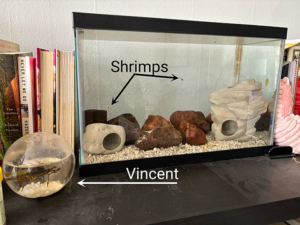 I resolved to break Vincent out of his EcoSphere. To build a social community, I adopted seven other ōpae’ula and established them in a five gallon fish tank next to Vincent’s EcoSphere. I’ve mapped out the precise steps required to transfer Vincent to the tank.
I resolved to break Vincent out of his EcoSphere. To build a social community, I adopted seven other ōpae’ula and established them in a five gallon fish tank next to Vincent’s EcoSphere. I’ve mapped out the precise steps required to transfer Vincent to the tank.
But doing so will risk Vincent’s life. Although I will drip acclimate him to the new tank’s water, the change could shock Vincent to death. Breaking open the EcoSphere and transferring Vincent could instantaneously crush his tiny, fragile body. And what if Vincent doesn’t even like the new tank? For every reason I have to relocate him, there are other justifications for keeping him where he is.
To help me ascertain the best possible direction, I’ve interviewed and pooled the wisdom and collective moral compass of several other thinkers and doers, including an ecologist who studies closed ecosystems, a conservationist, a writer on shrimp welfare, a university researcher, and a lab of graduate and undergraduate students whose work focuses on aquatic animal welfare.
Though I have been documenting the entire process, I will not complete this film until I’ve seen Vincent’s story through to some modicum of closure. Once the film is out in the world, I hope it encourages viewers to ask the same questions I’ve asked myself. What might it feel like to be Vincent, living alone in the same place for so long? How can I get to know him better? To what extent am I projecting onto him a concept of loneliness that only a human being can relate to? How can I really do right by Vincent? Should I risk his life to provide him with what might be a better home? Who am to think I know what’s best for him? To what extent can we humans treat the smallest of beings with empathy and dignity?
I’m working with a talented composer on the film’s score, editing the footage I’ve gathered to date, and gathering more. In preparation for Vincent’s potential transfer, I have been conducting micro experiments, like hiding half of Vincent’s EcoSphere in a dark place to see if he does indeed prefer darkness. I suppose that points to the most important question of all: What does Vincent want?
Matt Maraynes, April 2025
For more on Matt’s work visit Place for Animals and his page on social media (@placefor_animals).


